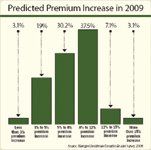State of the Industry 2009: Premiums
Chronic conditions, medical advances and consumerism are among the factors contributing to premium trends in 2009, experts say.
Chronic conditions, medical advances and consumerism are among the factors contributing to premium trends in 2009, experts say.
Predictions from MHE's State of the Industry survey are on par with those of Milliman's 2008 Group Health Insurance Survey, which indicates a 9.4% increase for PPO premiums and an 8.5% increase for HMOs in 2009. Milliman factors out differences in benefit design, cost sharing levels and member demographics to determine its premium forecast.
"The 8% or 9% numbers are reasonably low compared with the past five years," says Doug Proebsting, principal and consulting actuary for Milliman, and co-author of the report. "Premium rates peaked in 2002 when we were in the middle-teens...If I were to guess, I would say we are in an extended valley. We were at a high point a few years ago and started to flatline if not go down a little bit in each of the past couple years."
However, having said that, he also believes with overall healthcare spending as high as it is, percentage increases should be reviewed in context. The trend rate in either direction may slow as a result of overall costs, he says.

Potential factors pushing up the premium trend include rising prevalence of chronic conditions, cost-shifting impact from government programs and the nation's appetite for healthcare, which he predicts will remain strong, especially as medical advances provide new services. Among the counterbalances of the trend are added consumer awareness of costs, generic substitution, lower utilization with high-deductible plans and less money for discretionary care for some consumers.
In August, United Benefit Advisors released its 2008 survey, indicating the average premium increase this year for all plans was 7.4%, but those transitioning to a consumer-driven plan with lower premiums meant to offset higher deductibles saw a first-year premium decrease of 7.9%.
ADDITIONAL NUMBERS
Historical experience data and forecasts from a variety of sources help MCOs and employers devise their premium metrics. Employer costs, copay levels and deductibles will no doubt vary widely as managed care strategies are leveraged to keep premiums in check.
Buck Consultants measured the projected average annual increase in employer-provided healthcare benefit costs and found late-2008 and early-2009 cost trends among various plan designs in the double digits. PPOs are charting 11.1% increases; HMOs, 11.1%; POS plans, 10.8%; and consumer-driven/high-deductible plans, 10.7%, according to the survey.
PricewaterhouseCoopers (PwC) Health Research Institute in June noted that actual medical costs are expected to grow 9.6% in 2009, compared with a 9.9% rate in 2008 and double-digit growth in previous years, according to its survey of more than 500 employers. PwC forecasts that the downward trend is leveling off and that providers, employers and insurers must monitor costs carefully if they hope to avoid a repeat of double digits.
While medical costs alone do not determine premium increases, the two measures do tend to move in the same direction, according to PwC.
Aon Consulting Worldwide indicates in its insurer survey that many employers could see a cost increase of 10% in 2009-the smallest increase it has seen in six years. Aon attributes the moderation to employer efforts, such as wellness and disease management.
Extending the Capabilities of the EHR Through Automation
August 2nd 2023Welcome back to another episode of "Tuning In to the C-Suite," where Briana Contreras, an editor of Managed Healthcare Executive, had the pleasure of chatting with Cindy Gaines, chief clinical transformation officer at Lumeon.
Listen
Automate Your Practice's Workflows with These 5 Tools
October 4th 2023To maintain patient satisfaction and regulatory compliance and reduce potential clerical errors while maintaining high productivity, you can ease your staff’s burdens by automating your practice’s workflows and empower your staff to do more in less time.
Read More
Extending the Capabilities of the EHR Through Automation
August 2nd 2023Welcome back to another episode of "Tuning In to the C-Suite," where Briana Contreras, an editor of Managed Healthcare Executive, had the pleasure of chatting with Cindy Gaines, chief clinical transformation officer at Lumeon.
Listen
Automate Your Practice's Workflows with These 5 Tools
October 4th 2023To maintain patient satisfaction and regulatory compliance and reduce potential clerical errors while maintaining high productivity, you can ease your staff’s burdens by automating your practice’s workflows and empower your staff to do more in less time.
Read More
2 Commerce Drive
Cranbury, NJ 08512
All rights reserved.